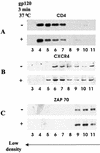Role of cholesterol in human immunodeficiency virus type 1 envelope protein-mediated fusion with host cells
- PMID: 12388719
- PMCID: PMC136803
- DOI: 10.1128/jvi.76.22.11584-11595.2002
Role of cholesterol in human immunodeficiency virus type 1 envelope protein-mediated fusion with host cells
Abstract
In this study we examined the effects of target membrane cholesterol depletion and cytoskeletal changes on human immunodeficiency virus type 1 (HIV-1) Env-mediated membrane fusion by dye redistribution assays. We found that treatment of peripheral blood lymphocytes (PBL) with methyl-beta-cyclodextrin (MbetaCD) or cytochalasin reduced their susceptibility to membrane fusion with cells expressing HIV-1 Env that utilize CXCR4 or CCR5. However, treatment of human osteosarcoma (HOS) cells expressing high levels of CD4 and coreceptors with these agents did not affect their susceptibility to HIV-1 Env-mediated membrane fusion. Removal of cholesterol inhibited stromal cell-derived factor-1alpha- and macrophage inflammatory protein 1beta-induced chemotaxis of both PBL and HOS cells expressing CD4 and coreceptors. The fusion activity as well as the chemotactic activity of PBL was recovered by adding back cholesterol to these cells. Confocal laser scanning microscopy analysis indicated that treatment of lymphocytes with MbetaCD reduced the colocalization of CD4 or of CXCR4 with actin presumably in microvilli. These findings indicate that, although cholesterol is not required for HIV-1 Env-mediated membrane fusion per se, its depletion from cells with relatively low coreceptor densities reduces the capacity of HIV-1 Env to engage coreceptor clusters required to trigger fusion. Furthermore, our results suggest that coreceptor clustering may occur in microvilli that are supported by actin polymerization.
Figures








Similar articles
-
The role of cholesterol and sphingolipids in chemokine receptor function and HIV-1 envelope glycoprotein-mediated fusion.Virol J. 2006 Dec 22;3:104. doi: 10.1186/1743-422X-3-104. Virol J. 2006. PMID: 17187670 Free PMC article.
-
Actin cytoskeletal reorganizations and coreceptor-mediated activation of rac during human immunodeficiency virus-induced cell fusion.J Virol. 2004 Jul;78(13):7138-47. doi: 10.1128/JVI.78.13.7138-7147.2004. J Virol. 2004. PMID: 15194790 Free PMC article.
-
Human immunodeficiency virus type 1 uses lipid raft-colocalized CD4 and chemokine receptors for productive entry into CD4(+) T cells.J Virol. 2002 May;76(10):4709-22. doi: 10.1128/jvi.76.10.4709-4722.2002. J Virol. 2002. PMID: 11967288 Free PMC article.
-
HIV envelope proteins differentially utilize CXCR4 and CCR5 coreceptors for induction of apoptosis.Virology. 2001 Jun 20;285(1):128-37. doi: 10.1006/viro.2001.0927. Virology. 2001. PMID: 11414813
-
Fusion mediated by the HIV-1 envelope protein.Subcell Biochem. 2000;34:457-81. doi: 10.1007/0-306-46824-7_12. Subcell Biochem. 2000. PMID: 10808341 Review. No abstract available.
Cited by
-
The Important Role of Lipid Raft-Mediated Attachment in the Infection of Cultured Cells by Coronavirus Infectious Bronchitis Virus Beaudette Strain.PLoS One. 2017 Jan 12;12(1):e0170123. doi: 10.1371/journal.pone.0170123. eCollection 2017. PLoS One. 2017. PMID: 28081264 Free PMC article.
-
Molecular docking as a tool for the discovery of novel insight about the role of acid sphingomyelinase inhibitors in SARS- CoV-2 infectivity.BMC Public Health. 2024 Feb 6;24(1):395. doi: 10.1186/s12889-024-17747-z. BMC Public Health. 2024. PMID: 38321448 Free PMC article. Review.
-
Ceramide, a target for antiretroviral therapy.Proc Natl Acad Sci U S A. 2004 Oct 26;101(43):15452-7. doi: 10.1073/pnas.0402874101. Epub 2004 Oct 15. Proc Natl Acad Sci U S A. 2004. PMID: 15489273 Free PMC article.
-
Role of Lipid Rafts in Pathogen-Host Interaction - A Mini Review.Front Immunol. 2022 Jan 20;12:815020. doi: 10.3389/fimmu.2021.815020. eCollection 2021. Front Immunol. 2022. PMID: 35126371 Free PMC article. Review.
-
Design and Characterization of Cholesterylated Peptide HIV-1/2 Fusion Inhibitors with Extremely Potent and Long-Lasting Antiviral Activity.J Virol. 2019 May 15;93(11):e02312-18. doi: 10.1128/JVI.02312-18. Print 2019 Jun 1. J Virol. 2019. PMID: 30867304 Free PMC article.
References
-
- Ben-Baruch, A., L. Xu, P. R. Young, K. Bengali, J. J. Oppenheim, and J. M. Wang. 1995. Monocyte chemotactic protein-3 (MCP3) interacts with multiple leukocyte receptors. C-C CKR1, a receptor for macrophage inflammatory protein-1 alpha/Rantes, is also a functional receptor for MCP3. J. Biol. Chem. 270:22123-22128. - PubMed
-
- Berger, E. A., P. M. Murphy, and J. M. Farber. 1999. Chemokine receptors as HIV-1 coreceptors: roles in viral entry, tropism, and disease. Annu. Rev. Immunol. 17:657-700. - PubMed
MeSH terms
Substances
LinkOut - more resources
Full Text Sources
Other Literature Sources
Medical
Research Materials

